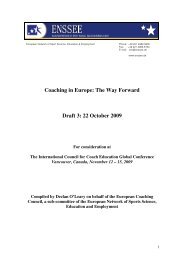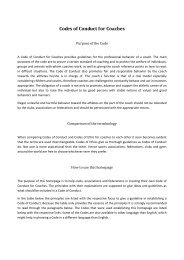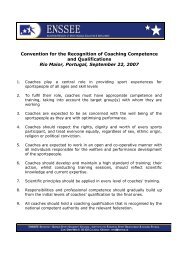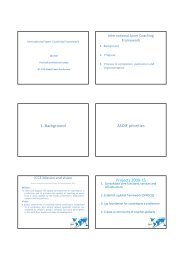International Sport Coaching Framework â version 1.1
International Sport Coaching Framework â version 1.1
International Sport Coaching Framework â version 1.1
You also want an ePaper? Increase the reach of your titles
YUMPU automatically turns print PDFs into web optimized ePapers that Google loves.
<strong>International</strong> <strong>Sport</strong> <strong>Coaching</strong> <strong>Framework</strong><br />
cate or licence from an approved coach education programme ensures quality<br />
in the coach development process. Properly structured educational coursework<br />
and demonstrated on-the-job mastery of that material to merit the award of a<br />
certificate or licence benefit everyone in sport.<br />
CURRICULUM DESIGN AND IMPLEMENTATION<br />
The design of coach certification programmes<br />
varies according to sport,<br />
nation and institutional context. Federations<br />
at the national and international<br />
levels take the lead in developing sportspecific<br />
certification courses. Institutions<br />
of higher education tend to focus their<br />
curricula on more universal topics such<br />
as sport science, coaching methods and<br />
theory, with varying degrees of sport<br />
specificity.<br />
Coach education, certification, and<br />
licensing programmes serve everyone<br />
best when labour market requirements,<br />
vocational competence and available<br />
coaching expertise shape their design<br />
and implementation. In some countries,<br />
there is strong input from the state, either<br />
through designated coaching organisations<br />
or through higher education. In such<br />
cases, relationships with national and<br />
international federations vary.<br />
National and international federations<br />
often determine certification requirements<br />
at designated coaching levels of<br />
Educational<br />
Institution<br />
their sports. Sometimes they align their sport-specific programmes with broader<br />
systems of certification at the state or higher education levels. Figure 7.1 outlines<br />
a process of curriculum design to maximise this alignment.<br />
MANDATORY CERTIFICATION<br />
<strong>Coaching</strong> Education Context<br />
<strong>Sport</strong><br />
Federation<br />
National/State<br />
Organisation<br />
Analyse coaching occupations and<br />
domains based on athlete need<br />
and structure of the sport<br />
Identify coaching functions, competence,<br />
knowledge and values<br />
Design learning outcomes, programmes<br />
and assessment tools<br />
Align with national qualifications systems<br />
and (where appropriate) international<br />
federation systems of recognition<br />
FIGURE 7.1 Curriculum design<br />
process.<br />
Figure 7.1<br />
Coaches all over the world devote vast amounts of time and energy to developing<br />
athletes. The majority of these coaches are volunteers, yet they are joined in the<br />
same blended profession by paid coaches in leadership roles.<br />
But when it comes to certification and what it should represent, coaches in all<br />
four roles—Master/Head Coach, Advanced/Senior Coach, Coach, and <strong>Coaching</strong><br />
Assistant—are equals. Except for pre-coaches, all active coaches should be<br />
35







